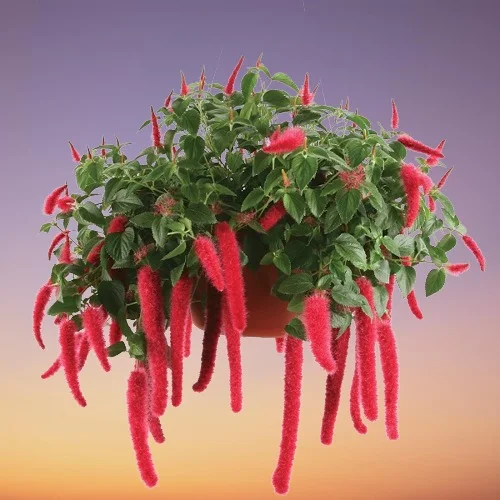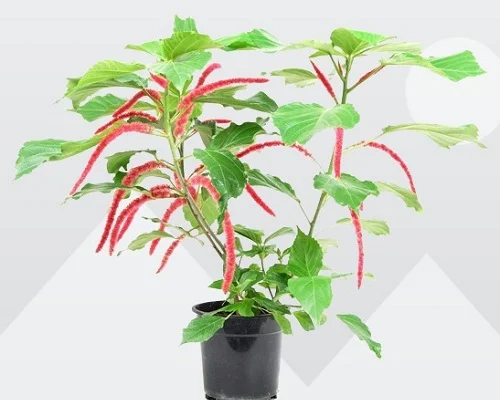10 Reasons Why Chenille Plant is Dying and their Remedies
Some links in this post may be affiliate links
Chenille Plant is dying due to root-rot, improper feeding, pest infestations, drafts, dry air, inconsistent watering, too little light, poor quality soil among others.
Chenille Plant which goes by the botanical name, Acalypha hispida, is also called Red Hot Cat Tail, Monkey Tail, Philippine Medusa or Foxtail.
Acalypha hispida is a popular houseplant on account of its pendulous, brilliantly colored, furry flowers. It grows best in bright indirect light, average warmth of 18-280C, humidity of 55-70% and moderately moist, rich, well drained soil coupled with fortnightly feeding in spring and summer. Learn how to grow and care for Chenille Plant.
If these conditions are not provided, the plant may die. Herebelow are 10 reasons why a Chenille Plant may die and how to solve them.

10 Reasons Why Chenille Plant is Dying and How to Fix Them
1. Root-rot disease
Chenille Plant is prone to root-rot disease which is characterized by yellowing, wilting and leaf drop, rapidly followed by browning and plant collapse. The disease is prevalent in soggy soil.
How to fix itCarefully, slip the plant out of its pot and inspect the roots. Brown-black mushy roots indicate root-rot, trim them off and treat the healthy roots with a copper-based fungicidal solution.
Disinfect the pot with the fungicidal solution or use a fresh pot to repot the plant in fresh free-draining soil.
Withhold watering and keep it dry for some time before resuming watering to allow it time to recover.
To prevent root-rot in the future, use a pot with a drainage hole and free-draining soil to prevent it from getting soggy.
Take care not to overwater in fall and winter as growth is minimal at this time, therefore, the plant does not need a lot of water.
2. Improper feeding
Overfeeding a Chenille Plant will cause the roots to die due to fertilizer burn. This means the roots cannot take up nutrients and water required for photosynthesis, thus, the plant begins to die due to lack of food.
On the other hand, underfeeding implies that the plant is not getting enough nutrients needed for growth, therefore, it begins to die.
How to fix itFeed your Chenille Plant with a phosphorous-rich, water-soluble fertilizer every 2-3 weeks in spring and summer to boost lush growth.
Do not feed in fall and winter to prevent fertilizer burn and death of the plant as growth is reduced at this time.
3. Pest infestations
Chenille Plant is prone to sap-sucking insects like mealybugs, whiteflies and spidermites which may cause the plant to become wilted, stunted, drop leaves and eventually die.
How to fix itMaintain your Chenille Plant healthy by providing the right growing conditions to minimize pests infestations as weak plants are more prone to pests.
The pest infestations are more prevalent in dry air conditions. Therefore, raise humidity to depress the infestations; set the pot on a wet pebble tray, use a humidifier or grow the plant in a well-lit bathroom.
Keep the plant well pruned by removing the dead and yellow foliage to improve air flow to discourage the pests.
Maintain a good air circulation for the plant to reduce the infestations.
If the infestation is heavy, isolate the affected plant to prevent spread to the other plants and treat it insecticidal soap or neem oil as per the manufacturers' instructions.

4. Being extremely pot-bound
Though a Chenille Plant grows best when slightly pot-bound, when it becomes extremely pot-bound it begins to wilt, drop leaves and eventually die.
This is because the roots have filled the pot and there is very little soil to hold water when the plant is watered which will cause the plant to wilt, drop leaves and may die.
How to fix itCheck the bottom of the pot for roots growing through the drainage hole and repot the plant into a pot one size larger than the current one.
Thereafter, repot the Chenille Plant at the beginning of the growing season (spring to early summer) when pot-bound. Check out these pots with drainage holes on Amazon.
5. Poor quality Soil
Poor quality soil does not drain easily and therefore it easily becomes compacted or soggy which can result in reduced growth, yellowing and death of the plant.
How to fix itGrow your Chenille Plant in a loose, well-drained soil to prevent waterlogging and compaction. A blend of 2 parts all purpose soil and 1 part perlite (for drainage) is ideal for this plant.
6. Dry air
If the air is too dry, it will result in very low humidity will negatively affect the growth of the plant. Low humidity will result in stunted growth, leaf drop and eventual death of the plant.
How to fix itChenille Plant thrives in a humidity of 55-70%. To increase humidity, group the plants together or grow the plant in a well-lit bathroom and other humid areas in the home. You may also set the pot on a wet pebble tray or use a humidifier to elevate humidity.
7. Too little light
Adequate light is necessary for photosynthesis, the process by which plants make food needed for growth and energy. Too little light means that the plant cannot make enough food for growth and development which results in slow growth and death of the plant.
How to fix itChenille Plant blossoms in bright indirect light away from direct sunlight. Move it to a brighter spot or instal a grow light if the natural lighting is not sufficient.
Regularly rotate the pot to ensure that the plant absorbs enough light for photosynthesis on all sides for uniform growth as well as prevent legginess.

8. Inconsistent watering
Both overwatering and underwatering negatively impact the growth of the plant. Overwatering will cause the roots to die due to lack of oxygen. Therefore, they cannot take up water which results in rotting, yellowing, leaf drop and eventual death of the plant.
Underwatering implies that there is too little moisture in the soil for the plant to take up to the leaves. This causes wilting, yellowing, leaf drop and eventual death of the plant if the situation is not corrected.
How to fix itWater your Chenille Plant when the top 2-3 inches of soil dry out but do not allow the soil to dry out completely. Do not water on a schedule to avoid either overwatering or underwatering.
Use a pot that has a drainage hole and a well-draining soil to prevent waterlogging of the soil.
9. Exposure to direct sunlight
Exposing your Chenille Plant to direct sunlight for too long will result in scorching, wilting, yellowing, leaf drop and eventual death if the situation is not rectified.
How to fix itPosition your Chenille Plant in a more shaded spot or instal a light curtain to shield the plant from direct sunlight to prevent its eventual death.
10. Drafts
Both cold and hot drafts will cause sudden temperature flactuations which will lead to stunted growth, yellowing, leaf drop and eventual death of the plant.
How to fix itKeep your Chenille Plant away from sources of drafts like AC units, hot air vents, stoves, windy doors, drafty windows among others to maintain an average warmth of 18-280C.
You liked it? Share on social media.
Related Content
Amazon Associates Disclosure
Homeplantsguide.com is a participant in the Amazon Services LLC Associates Program, an affiliate advertising program designed to provide a means for sites to earn advertising fees by advertising and linking to amazon.com.


